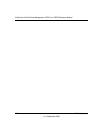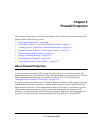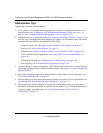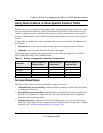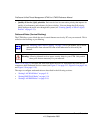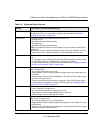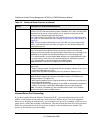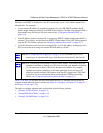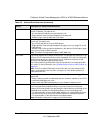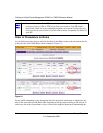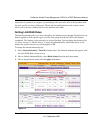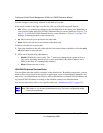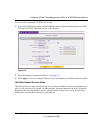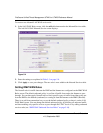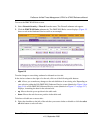
ProSecure Unified Threat Management UTM10 or UTM25 Reference Manual
5-8 Firewall Protection
v1.0, September 2009
.
Table 5-3. Inbound Rules Overview
Setting Description (or Subfield and Description)
Service The service or application to be covered by this rule. If the service or application does
not appear in the list, you must define it using the Services menu (see “Adding
Customized Services” on page 5-30).
Action (Filter) The action for outgoing connections covered by this rule:
• BLOCK always.
• BLOCK by schedule, otherwise allow.
• ALLOW always.
• ALLOW by schedule, otherwise block.
Note: Any inbound traffic that is not blocked by rules you create is allowed by the
default rule.
Select Schedule The time schedule (that is, Schedule1, Schedule2, or Schedule3) that is used by this
rule.
• This pull-down menu is activated only when “BLOCK by schedule, otherwise allow”
or “ALLOW by schedule, otherwise block” is selected as the Action.
• Use the schedule screen to configure the time schedules (see “Setting a Schedule
to Block or Allow Specific Traffic” on page 5-39).
Send to LAN Server The LAN server address determines which computer on your network is hosting this
service rule. (You can also translate this address to a port number.)
Send to DMZ Server The DMZ server address determines which computer on your network is hosting this
service rule. (You can also translate this address to a port number.)
Translate to Port
Number
You can enable this setting and specify a port number if you want to assign the LAN
server or DMZ server to a specific port.
WAN Destination IP
Address
The setting that determines the destination IP address applicable to incoming traffic.
This is the public IP address that maps to the internal LAN server.
On the UTM25, it can either be the address of the WAN1 or WAN2 interface or
another public IP address (when you have a secondary WAN address configured)
.
On the UTM10, it can either be the address of the single WAN interface or another
public IP address (when you have a secondary WAN address configured)
.
LAN Users The settings that determine which computers on your network are affected by this
rule. The options are:
• Any. All PCs and devices on your LAN.
• Single address. Enter the required address to apply the rule to a single device on
your LAN.
• Address range. Enter the required addresses in the Start and Finish fields to apply
the rule to a range of devices.
• Groups. Select the Group to which the rule applies. Use the LAN Groups screen
(under Network Configuration) to assign PCs to Groups. See “Managing Groups
and Hosts (LAN Groups)” on page 4-12.
Note: This field is not applicable to inbound LAN WAN rules.



